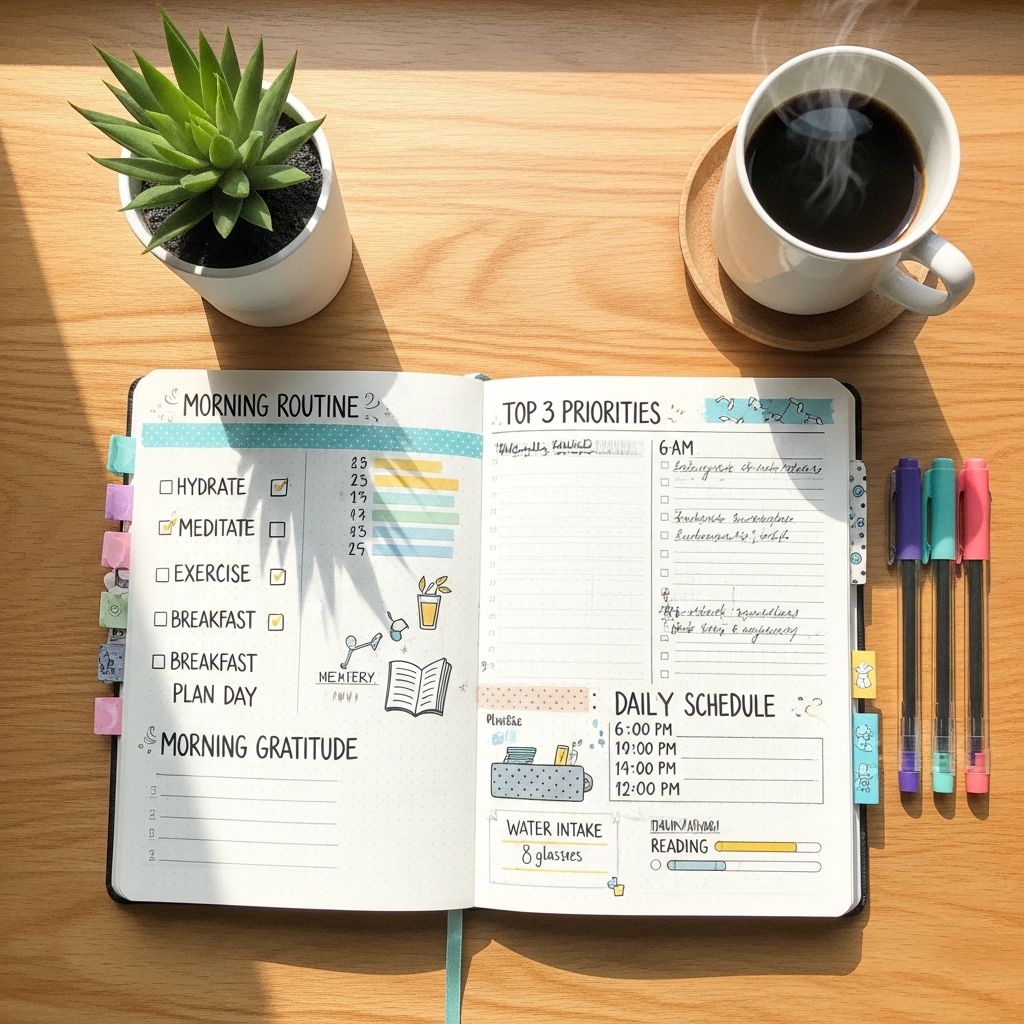A Morning Bullet Journal Layout to Boost Daily Success
Start every day clear-headed and focused with this intentional morning bullet journal approach that integrates planning, reflection, and productivity.

Building an intentional and effective morning routine can be the catalyst for a more productive, balanced, and satisfying day. Among the many approaches that can help streamline your mornings, a thoughtfully designed morning bullet journal offers an accessible framework for focusing your mind, clarifying your goals, and managing your tasks with clarity. This article walks you through a comprehensive bullet journal system specifically designed for the morning, inspired by best wellness practices, to empower you to start each day with intention and purpose.
Why a Morning Bullet Journal?
A morning bullet journal is more than a to-do list—it’s a mindful ritual that encourages you to tune into your priorities, clear mental clutter, and carve out space for self-care. By combining elements of journaling, time management, and creative reflection, this practice can:
- Increase daily productivity by helping you identify and focus on your top priorities.
- Relieve stress through brain dumping and emotional processing.
- Strengthen routines by offering a consistent morning anchor.
- Cultivate self-awareness and intention with reflective prompts and gratitude practices.
The Essentials: Key Sections of a Morning Bullet Journal
The foundation of this method lies in dividing your journal into practical, easy-to-maintain sections. Each section serves a unique role in organizing your thoughts, getting clear on what matters most, and building a daily rhythm that’s both productive and purposeful. The main components are:
- Brain Dump
- Top Three Priorities
- Small To-Dos
- Daily Schedule
Brain Dump: Clearing the Mental Clutter
This is the space to write down everything on your mind—tasks, worries, ideas, or random thoughts—without worrying about organization or logic. The goal is to create a mental blank slate, reducing overwhelm and making space for clarity. You might not brain dump every morning, but on days when you feel especially busy or scattered, starting here can be invaluable.
- Jot down every thought, big or small.
- Allow yourself to be messy and unfiltered.
- Use this to identify hidden anxieties or urgent to-dos.
Top Three: Honing in on What Matters Most
Once your mind is clearer, select your top three priorities for the day. These should be achievable and meaningful—if you do nothing else, finishing these will make the day feel successful. It’s important not to make this list overwhelming; include personal, professional, or self-care goals. Setting these helps you avoid the trap of a never-ending list and returns you to what truly matters.
- Keep it realistic—three tasks you genuinely can finish today.
- Balance work with personal well-being whenever possible.
- Reflect on these choices: Why are they a priority?
Small To-Dos: Capturing the Rest
The rest of your tasks, those that are less urgent or quick, go here. These could be emails to send, recurring household chores, or wish-list items you don’t want to forget. This list not only keeps your day organized but also prevents you from feeling guilty if these aren’t completed—they’re secondary.
- Quick tasks: calls, errand reminders, emails.
- Non-urgent or ongoing responsibilities.
- Quick wins or tasks to schedule later in the week.
Daily Schedule: Designing Your Day
Finally, map out your day. This can be as simple as listing time blocks, or as detailed as scheduling out each hour. Many productivity enthusiasts recommend time blocking—allocating set periods for focused work followed by short, restorative breaks. The Pomodoro Technique is a popular version: work for 25 minutes, then take a five-minute break.
- Block out time for deep work sessions.
- Include breaks to maintain energy and mental clarity.
- Allow space for flexibility if unexpected tasks arise.
How to Set Up Your Morning Bullet Journal
Creating an effective morning bullet journal layout is both practical and personal. Here’s a recommended step-by-step template to help you get started:
| Section | Purpose | Tips for Use |
|---|---|---|
| Brain Dump | Clear mental clutter and spark self-awareness | Write non-stop for 5 minutes. Don’t edit or censor—just flow. |
| Top Three | Identify your three most crucial goals | Choose realistic priorities and check them throughout the day. |
| Small To-Dos | Organize minor or non-urgent tasks | Reference this list when you have spare time; migrate to-dos as needed. |
| Daily Schedule | Time block your work and breaks | Use a digital or paper format. Try Pomodoro sessions for focus. |
Integrating Reflection and Intention
Beyond productivity, bullet journaling can be a chance for personal reflection and setting daily intentions. Consider incorporating brief prompts at the end or beginning of your journal session:
- What is one thing I’m grateful for today?
- What would make today feel successful?
- How am I feeling—physically, emotionally, mentally?
- What is my intention for the day?
Answering these questions can help you maintain perspective and ground even the busiest days in mindful awareness.
Tips for Making It a Sustainable Habit
The key to reaping the benefits of a morning bullet journal is consistency over perfection. Here’s how to make the practice stick:
- Designate a specific time each morning—even if only five minutes—to journal.
- Keep your tools accessible—use a notebook, digital app, or tablet that feels inviting.
- Embrace imperfection: Let the practice fit your needs rather than following a rigid formula.
- Occasional flexibility: Some mornings may be busier; on those days, a quick priority list is better than skipping altogether.
Sample Morning Bullet Journal Layout
Below is an example of a one-page bullet journal spread that incorporates all the essential sections:
Brain Dump:- Meeting at 10am—prep presentation?- Need to defrost dinner for tonight- Call mom about weekend plansTop Three:1. Finish quarterly report draft2. 30-minute workout3. Plan family meals for the weekSmall To-Dos:- Reply to team emails- Put away laundry- Check on package deliveryDaily Schedule:7:00 Coffee, journaling7:30 Gym or at-home workout8:30 Review emails9:00 Focus block #1 (work project)10:00 Meeting... (continue as needed)
Benefits of a Morning Bullet Journal Approach
- Mitigates overwhelm by providing an external place for racing thoughts and plans.
- Focuses energy on impactful actions, not busywork.
- Promotes self-care by integrating reflection and intention.
- Improves time management through thoughtful scheduling and prioritization.
- Cultivates mindfulness as you start each day intentionally.
Frequently Asked Questions
Q: What makes a bullet journal different from a regular planner?
A: Unlike dated planners, a bullet journal is a flexible, customizable system. You design your own layouts and include as much (or as little) structure as works for you. This method is ideal for those seeking a blend of productivity and creativity.
Q: How long should I spend on my morning bullet journal?
A: Even five to ten minutes can make a meaningful difference. The practice is most impactful when it’s consistent, not time-consuming. Some days, you may write more, other days simply jotting your top three priorities is enough.
Q: Should I do my journaling on paper or digitally?
A: Both approaches work. Many people prefer handwriting for its creative flow and brain benefits, while others use tablets or apps (like Evernote) for easy searching and organization. Experiment to find your preferred style.
Q: How do I stay motivated to keep up the habit?
A: Make it enjoyable—use pretty supplies, keep your tools within reach, and celebrate the small wins of journaling. Connecting the habit to something you already do (like morning coffee) helps it stick.
Morning Bullet Journal Pro Tips
- Pair journaling with another enjoyable morning ritual, like meditation or a healthy breakfast.
- Use color coding or icons for quick visual organization.
- Don’t be afraid to switch up your layout periodically—flexibility keeps the practice fresh.
- If you’re new, start small; even outlining your top three priorities can change the tone of your entire day.
Adapting for Different Seasons of Life
Your routine may need to flex during busy periods, life changes, or if you have young children or new responsibilities. Give yourself permission to adapt your bullet journal practice as needed—sometimes, simply capturing your three main objectives is enough.
Remember, the value lies in showing up for yourself daily, no matter how simple your strategy.
Conclusion: Designing Your Mornings with Intention
Embracing a morning bullet journal ritual sets a deliberate and empowering tone for the rest of your day. This method isn’t about perfection; it’s about presence, clarity, and self-compassion. By carving out a few moments each morning to anchor your thoughts, organize priorities, and foster mindful reflection, you give yourself a powerful foundation—one that supports productivity and nurtures your well-being in equal measure. Why not try setting up your bullet journal tomorrow and see how it transforms your mornings?
References
- https://thechalkboardmag.com/mornings-camille-styles-pinterest-foam-rollers-alarm-clocks/
- https://camillestyles.com/wellness/morning-bullet-journal/
- https://camillestyles.com/wellness/morning-routine/camille-styles-morning-routine/
- https://camillestyles.com/wellness/why-journaling-deserves-a-place-in-your-quarantine-routine/
- https://camillestyles.com/wellness/morning-pages/
- https://camillestyles.substack.com/p/morning-routine-toolkit
- https://camillestyles.com/wellness/journaling-tips/
- https://camillestyles.com/wellness/morning-routine/
- https://www.youtube.com/watch?v=-V5GXnJqGP4
- https://camillestyles.com/wellness/monthly-routine-tips/












